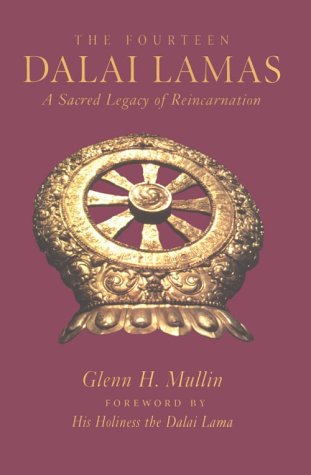 The Fourteen Dalai Lamas:
The Fourteen Dalai Lamas:
A Sacred Legacy of Reincarnation
Glenn H. Mullin
Clear Light Books: Santa Fe, 2001
576 pp.; $29.95 (cloth)
Who’s the most famous Buddhist in the world? That’s easy: His Holiness the Fourteenth Dalai Lama. From humble origins in Tibet he has become a Nobel Prize winner and a spiritual guide to millions. But while the present incarnation’s story is familiar to many, few outside Asia are aware of the sheer bulk of legends and history attached to the person of the Dalai Lama. To those seeking to understand the Dalai Lama in his full context, not only as a brilliant contemporary teacher but as a timeless guide and protector of Buddhism in Central Asia, The Fourteen Dalai Lamas will provide ample insight.
Glen Mullin’s many books on Tibetan Buddhism—which include over a dozen books on the current and previous Dalai Lamas—make him one of the few Westerners qualified to tackle the task of untangling their previous lives and accomplishments, a backdrop that actually precedes the first Dalai Lama. As Mullin points out, the Dalai Lamas are seen as incarnations of Avalokiteshvara, the Bodhisattva of Compassion. Since in Tibetan Buddhism bodhisattvas can take on numerous forms simultaneously, possess great mystical powers, and incarnate life after life for aeons, Mullin’s book is no ordinary biography. In one form or another, the Dalai Lama is traditionally credited with everything from the making of modern Tibet to fathering the human race. In between, he’s variously been a celibate monk, a highly sexed tantric Casanova, assorted important kings, and virtually anyone else who played a role in bringing Buddhism to Tibet and safeguarding both the tradition and its new homeland.
Mullin’s approach to this fantastic story is not academic. He frequently criticizes other Western biographers of the Dalai Lama for “a lack of knowledge of Tibetan culture in general and Tibetan Buddhism in particular,” and presents the unending series of miracles surrounding the Dalai Lamas’ stories matter-of-factly. In doing so, he demonstrates his personal beliefs as a Buddhist in the Vajrayana tradition. But while this is a Vajrayana telling of the Dalai Lamas’ tales, it is not a wholly Tibetan one. Mullin sometimes argues against the accepted Tibetan version of events, offering alternate readings of history based on other sources of information, along with interviews with key players. Thus, even those familiar with the long line of Dalai Lamas will find a fresh perspective here.
Mullin frequently takes pains to explain why he feels the historical record demonstrates the fallacy of Communist China’s claims to Tibet. And his text also punctures the many Western fantasies of Tibet as an untouched spiritual paradise. The entire story of the Dalai Lamas roils with political and sectarian intrigue, foreign invasions, and seemingly larger-than-life personalities contending with each other for the fate of Tibet.
To his credit, Mullin seems aware that he has written a huge volume on a complicated subject that may confuse many interested readers. He reminds us when important characters from previous chapters reappear, refers back to influential events in the earlier lives of the Dalai Lamas, and does an excellent job of placing events in their historical, cultural, and religious contexts. Considering that he is dealing with centuries of foreign tradition steeped in mysticism and remote mountain culture, Mullin manages to describe the central events that formed the Dalai Lamas’ stories in such a way that they all make sense. It would have been helpful, though, if the book had included a glossary.
The work contains many beautiful teachings, poems, and prayers from the various Dalai Lamas themselves. It also serves up a wealth of information explaining how the position of the Dalai Lama became what it is today, ranging from the source of the name “Dalai” to the esoteric methods for discovering new Dalai Lama incarnations. The Fourteen Dalai Lamas is best digested one chapter at a time. It took more than a thousand years for the Tibetan tradition to develop, and taking it all in slowly will afford the reader greater appreciation for this continually unfolding saga. ▼